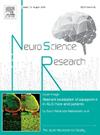反复经颅磁刺激频率对意识障碍患者血流动力学反应的影响。
IF 2.4
4区 医学
Q3 NEUROSCIENCES
引用次数: 0
摘要
重复经颅磁刺激(rTMS)是一种很有前途的无创神经调节技术,用于治疗意识障碍(DOC)患者。rTMS参数的选择对临床治疗效果有显著影响。然而,不同rTMS刺激频率下大脑时空反应的差异尚不清楚。在这项初步研究中,使用功能性近红外光谱(fNIRS)来评估rTMS在不同频率(1、5、10、15和20Hz)下在左背外侧前额叶皮层(F3)引起的血流动力学反应的时空差异。结果显示,rTMS诱发的血流动力学反应在不同频率下的分布模式不同,表明rTMS频率影响DOC患者的血流动力学反应。具体而言,10Hz rTMS在额叶皮层,特别是右背外侧前额叶皮层(R-DLPFC)引起了强烈的正血流动力学反应。此外,20Hz rTMS在运动相关皮层,特别是右侧运动前皮层(R-PreM)和右侧初级感觉运动皮层(PSMC)上产生了大量阳性血流动力学反应。目前的研究结果表明,fNIRS可以作为一种有前途的工具来评估rTMS对DOC患者的影响。为临床环境下rTMS参数的个性化设计提供了有益的指导。本文章由计算机程序翻译,如有差异,请以英文原文为准。
Repetitive transcranial magnetic stimulation frequency influences the hemodynamic responses in patients with disorders of consciousness
Repetitive transcranial magnetic stimulation (rTMS) emerges as a promising non-invasive neuromodulation technique for the treatment of patients with disorders of consciousness (DOC). The selection of rTMS parameters significantly influences the clinical therapeutic effects. However, the differences in spatiotemporal responsiveness of the brain under different rTMS stimulation frequencies remain unclear. In this pilot study, functional near-infrared spectroscopy (fNIRS) was used to evaluate the spatiotemporal differences in hemodynamic responses elicited by rTMS at different frequencies (1, 5, 10, 15, and 20 Hz) over left dorsolateral prefrontal cortex (F3). The results showed that the distribution patterns of the rTMS-evoked hemodynamic responses varied across different frequencies, indicating that rTMS frequency influences the hemodynamic responses in patients with DOC. Specifically, 10 Hz rTMS evoked strong positive hemodynamic responses over the frontal cortex, particularly in the right dorsolateral prefrontal cortex (R-DLPFC). Additionally, 20 Hz rTMS produced largepositive hemodynamic responses over the motor-related cortex, especially the right premotor cortex (R-PreM) and right primary sensorimotor cortex (PSMC). The current findings suggested that fNIRS can be used as a promising tool for evaluating the effects of rTMS in patients with DOC. Moreover, it provides useful guidance for the personalized design of rTMS parameters in a clinical environment.
求助全文
通过发布文献求助,成功后即可免费获取论文全文。
去求助
来源期刊

Neuroscience Research
医学-神经科学
CiteScore
5.60
自引率
3.40%
发文量
136
审稿时长
28 days
期刊介绍:
The international journal publishing original full-length research articles, short communications, technical notes, and reviews on all aspects of neuroscience
Neuroscience Research is an international journal for high quality articles in all branches of neuroscience, from the molecular to the behavioral levels. The journal is published in collaboration with the Japan Neuroscience Society and is open to all contributors in the world.
 求助内容:
求助内容: 应助结果提醒方式:
应助结果提醒方式:


